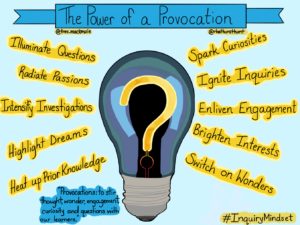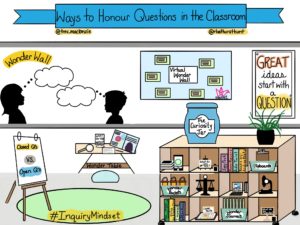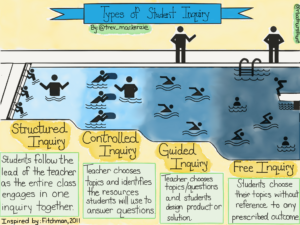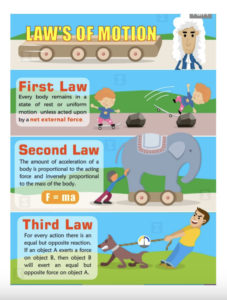Hi everyone!
I decided to look deeper into Inquiry based approach for our second blog post!
Mara and I formed a learning pod with Elementary Education in mind, and I’d like to talk a bit about what is Inquiry based learning, how to use this approach, what is so special about it, and some of my personal thoughts on it today.
First of all, let’s go over the definition.
Inquiry – “The dynamic process of being open to wonder and puzzlements and coming to know and understand the world” – Alberta Focus on Inquiry, 2004
Inquiry-based learning – “A process where students are involved in their learning, create essential questions,investigate widely, and then build new understandings, meanings, and knowledge. Knowledge is new to the students and maybe used to answer their essential question, to develop a solution, or to support a position or point of view. The knowledge is usually presented to others in some sort of a public manner and may result in some sort of action.” – Alberta Focus on Inquiry, 2004
Inquiry based approach allows students to take a lead/control on their learning, follow their curiosity, while scaffolded the general process by the instructor (aka classroom teacher).
What does this exactly mean… Let’s look deeper into this.
So how do we start this?
First, let’s take a look at this image that shows the overall process of this learning approach.

https://www.learningpersonalized.com/interview-with-trevor-mackenzie/
- Determine your focus.
Are we exploring your passion? Delving into curiosity? Aiming for a goal? Or taking on a new challenge? (This is also known as the four pillars of inquiry).
Example topic: Spider
- Come up with an essential question.
This could come from you or from your learners. Provide provocations such as prompts, videos, books, activities, etc. to motivate students to explore and further their curiosity and passion.

https://www.trevormackenzie.com/posts/2018/2/13/the-power-of-the-provocation
Example: How do spiders survive?
- Brainstorm questions.

https://twitter.com/trev_mackenzie/status/974621277313941504/photo/2
Example: What do spiders eat? Where do they live? How do they protect themselves?
- Brainstorm subtopics.
In this case, give students few kinds of spiders that they could possibly look further into.
- Select a subtopic.
Example: 5 students pick jumping spiders, 4 students pick tarantulas…etc.
- Access prior knowledge.
In small group, brainstorm what they already know about these spiders and record them and share.
- Identify wondering.
What do you wonder..? What do you want to know more about?
- Research.
Provide your learners with a booklet or some kind of medium where they can record their learning. Digital portfolio is also great if you have access to electronics, because photographs and videos can be a powerful tool to capture students’ learning journey!
- Make cross curricular connections.
Example: Apply it to PE, come up with some games using their unique movement
- Perform, Reflect, and Revise.
This is the final stage of the inquiry journey. “Provide opportunities for your students to receive formative feedback throughout this process and equip them with the language and understanding to self-assess their work. Build in time to reflect and revise both before their demonstrations of understanding and after feedback is given” (Inquiry mindset, p.30) Showcasing students’ learning such as public display is a great way to show their achievements.
Example: Student groups create an art mural to depict what spiders need/do to survive
Now let’s talk about the types of Student inquiry.
There are 4 main ways for the teacher and students’ to start this inquiry process: Structured inquiry, Controlled Inquiry, Guided inquiry, and Free inquiry.
Scaffolding is critical during this process and this is where this type of learning approach can get a bit chaotic and “messy” if not done right. We do not want to throw students in the deep end of the pool without teaching them how to swim first. Here is a good image that explains a bit better of what this means.
 https://www.trevormackenzie.com/posts/2018/1/16/what-youll-discover-when-you-read-dive-into-inquiry
https://www.trevormackenzie.com/posts/2018/1/16/what-youll-discover-when-you-read-dive-into-inquiry
So, why Inquiry based approach?
Here are the top 10 reasons why this learning approach is effective.
- Nurture student passions & talents
- Empower students voice and honour student choice
- Increase motivation and engagement
- Foster curiosity and love for learning
- Teach grit, perseverance, growth mindset and self regulation
- Make research meaningful and develop strong research skills (Great skills to practice from young age! Preparing them for future!)
- Deepen understanding to go beyond memorizing facts and content (go past and beyond the traditional way of learning)
- Fortify the importance of asking good questions (something that leads to next)
- Enable students to take ownership of their learning and to reach their goals
- Solve the problems of tomorrow in the classroom of today! (Foster global leader – someone we need in the twnety-first century! “memorization of facts and performance of routine tasks we see in traditional classroom are becoming less important. Curiosity, creativity, initiative, multidisciplinary thinking, and empathy prepare learners for a constantly changing world” (MacKenzie & Bathurst-Hunt, 2018, p.43)
Our goal is for “students to see learning your room as ideas, problems, and challenges demanding their voices and their expertise” (MacKenzie & Bathurst-Hunt, 2018, p.10)
Personal comment, and how Inquiry based approach is connected to Mara and myself’s learning resources?
Mara and I are considering taking in this approach into our learning resources. We are still in the process of brainstorming and building up, but I think this learning approach is a great way to better meet the needs of our learners, teaching them not only the overall essential learning skills but also allowing multiple ways for them to show their learning in many ways. Especially in elementary age group, I think this learning style accommodates many types of learners, especially those who find traditional way of learning boring, quizzes and tests very intimating, and those who are shy and introverted, not letting them ever that that “they are not smart enough”. Teachers often times see the side of the students that they didn’t know existed. It really drew me into the idea because when our learners are exploring a topic they are truly interested in and passionate about, engagement increases, work ethic improves, skills that are useful and necessary in life get acquired, and the overall energy towards learning and collaboration amongst learners are fostered. I believe this style of approach allow teachers to assess student understanding better as well because their learning evidence are more clear and accurate.
Reference:
Focus on Inquiry: A teacher’s guide to implementing inquiry-based learning. Edmonton: Alberta Learning, 2004. open.alberta.ca/dataset/032c67af-325c-4039-a0f3-100f44306910/resource/b7585634-fave-4488-a836-af22f1cbab2a/download/29065832004focusoninquiry.pdf.
MacKenzie, T. (2018, January 17). What You’ll Discover When You Read Dive into Inquiry. Retrieved October 03, 2020, from https://www.trevormackenzie.com/posts/2018/1/16/what-youll-discover-when-you-read-dive-into-inquiry
MacKenzie, T. (2018, February 14). The Power of the Provocation. Retrieved October 03, 2020, from https://www.trevormackenzie.com/posts/2018/2/13/the-power-of-the-provocation
Mackenzie, T [@trev_mackenzie]. (2018, March 16.) Day11: Ways to Honour Questions in the Classroom! How amazing is this?! Pre-order #InquiryMindset today & get access to our exclusve content! [Tweet]. Twitter. https://mobile.twitter.com/trev_mackenzie/status/974621277313941504/photo/2
Trevor MacKenzie Interview: Questions and Inquiry. (2018, August 1). Learning Personalized. https://www.learningpersonalized.com/interview-with-trevor-mackenzie/
MacKenzie, T., & Batburst-Hunt, R. (2018). Inquiry Mindset: Nurturing the Dreams, Wonders, and Curiosities of Our Youngest Learners. Place of publication not identified: Elevate Books Edu.






Recent Comments